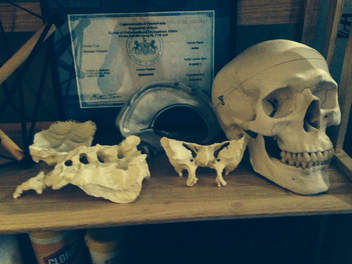CRANIOSACRAL THERAPY(CST)

"Craniosacral" is a term that originated in the early 1900's with an Osteopath named William Garner Sutherland. Dr Sutherland's life's work evolved around the premise that the bones of the skull maintained their joints and were designed to move. He developed techniques to treat these joints and influence the craniosacral system. Dr Sutherland is considered the founder of Cranial Osteopathy.
John Erwin Upledger D.O., is credited with bringing Dr Sutherland's work to the world on a much larger scale, by training licensed healthcare practitioners in craniosacral techniques, and expanding Craniosacral Therapy to include "SomatoEmotional Release." Dr Upledger coined this term to refer to the release of emotions that have become trapped in bodily tissues.
What is the craniosacral system?
The craniosacral system consists of the cerebrospinal fluid (CSF), the skull bones (cranium), the tailbone (sacrum), the structures involved in producing and circulating cerebrospinal fluid, and the membranes that contain the brain and spinal cord (central nervous system). Examples of more commonly recognized systems in the body, are the circulatory system and the respiratory system. These bodily systems have inherent rhythms. The circulatory system has the heartbeat. The respiratory system has the breath cycle. The craniosacral system also has a rhythm. This rhythm is created by the manufacture and subsequent filling and draining of the cerebrospinal fluid within its membranous confines.
A skilled Craniosacral Therapist will use techniques to "listen" to the subtle rhythms of the cerebrospinal fluid and make evaluations based on specific criteria. The art of "listening" to the body in this manner begins the process of becoming a witness to its innate wisdom and a facilitator, supporting the body's ability to change and self-regulate.
John Erwin Upledger D.O., is credited with bringing Dr Sutherland's work to the world on a much larger scale, by training licensed healthcare practitioners in craniosacral techniques, and expanding Craniosacral Therapy to include "SomatoEmotional Release." Dr Upledger coined this term to refer to the release of emotions that have become trapped in bodily tissues.
What is the craniosacral system?
The craniosacral system consists of the cerebrospinal fluid (CSF), the skull bones (cranium), the tailbone (sacrum), the structures involved in producing and circulating cerebrospinal fluid, and the membranes that contain the brain and spinal cord (central nervous system). Examples of more commonly recognized systems in the body, are the circulatory system and the respiratory system. These bodily systems have inherent rhythms. The circulatory system has the heartbeat. The respiratory system has the breath cycle. The craniosacral system also has a rhythm. This rhythm is created by the manufacture and subsequent filling and draining of the cerebrospinal fluid within its membranous confines.
A skilled Craniosacral Therapist will use techniques to "listen" to the subtle rhythms of the cerebrospinal fluid and make evaluations based on specific criteria. The art of "listening" to the body in this manner begins the process of becoming a witness to its innate wisdom and a facilitator, supporting the body's ability to change and self-regulate.

What is Craniosacral Therapy (CST)?
One of my mentors in this amazing modality is Don Ash, P.T., CST-P. He is the founder of the Craniosacral Therapy Alliance (CSTA), in Stafford, New Hampshire. Don is a world-renowned CST instructor, author, and was a personal friend and colleague of Dr John Upledger for over 20 years. He would tell you that "Craniosacral Therapy is a manual therapy technique consisting of light touch, listening, and good intentions; to engage the tissues, evaluate, and encourage the body to change and heal itself." The gentleness of this work is in contrast to the profoundly positive effect it can have on a broad spectrum of health conditions.
Who can benefit?
People of all ages can benefit from Craniosacral Therapy. Newborn infants to people in their 90's and beyond. Some conditions that can be helped with CST include:
- headaches/migraines
- problems of the central nervous system
- endocrine issues
- neck and back pain
- inflammatory responses
- TMJ dysfunction
- some types of depression
- nervous disorders/anxiety
- PTSD
- post-concussive syndrome
- many other conditions
Its not necessary to have a "problem" in order to benefit from CST. A big part of the job of the cerebrospinal fluid is to take away debris and to provide nutrients to the components of the central nervous system. Anything that benefits the central nervous system makes a positive contribution to the overall health and function of every system in the body.